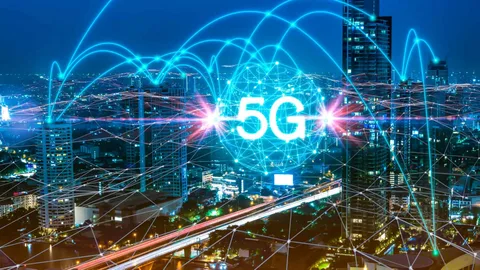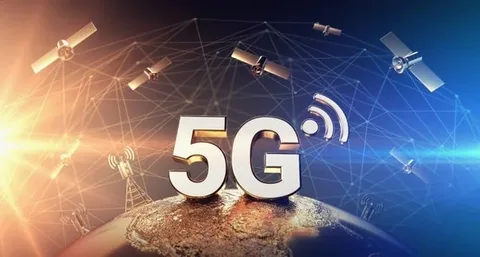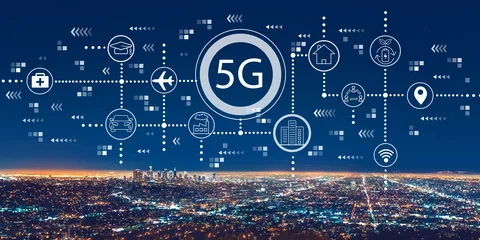Ushering in a New Era of Communication with 5G Technology
Introduction
The launch of 5G technology marks a groundbreaking milestone in the evolution of wireless communication. Building on the foundation of its predecessor, 4G, this new generation of connectivity is set to redefine the way we interact with technology, transforming everything from how we communicate to how industries operate.
With its unprecedented speed, ultra-low latency, and capacity to connect billions of devices, 5G is more than just an upgrade—it’s a technological revolution. Industries such as healthcare, education, transportation, and entertainment are already gearing up to harness its potential. As we stand on the brink of this new era, it is clear that 5G will play a pivotal role in shaping the future of global communication and connectivity.
The Far-Reaching Implications of 5G Technology
Enhanced Mobile Broadband
The introduction of 5G brings unparalleled data speeds that dwarf those of 4G. Imagine downloading a full-length HD movie in seconds or streaming 4K videos without a single buffer. This enhancement not only improves user experiences but also opens new opportunities for industries such as entertainment, e-commerce, and digital content creation.
For instance, live streaming events in ultra-high-definition or enabling augmented reality (AR) shopping experiences will become the norm. This surge in broadband capabilities is set to redefine how we consume digital content.
Ultra-Reliable Low-Latency Communication (URLLC)
Latency, the delay between sending and receiving data, has been a limiting factor for real-time applications. With 5G, latency is reduced to as low as one millisecond, paving the way for groundbreaking innovations:
- Remote Surgery: Surgeons can operate on patients thousands of miles away using robotic systems connected via 5G.
- Autonomous Vehicles: Self-driving cars can communicate with each other and traffic systems in real time, enhancing safety and efficiency.
- Industrial Automation: Factories can deploy robots and AI systems that respond instantly to changes, boosting productivity.
Massive Machine-Type Communications (mMTC)
The Internet of Things (IoT) is poised to flourish under 5G. This technology can connect a vast number of devices simultaneously, from smart home gadgets to industrial sensors. Imagine smart cities where traffic lights adjust dynamically based on real-time traffic data or homes equipped with AI-powered energy systems that optimize electricity usage.
This ability to connect billions of devices seamlessly will lead to innovations in areas such as agriculture (smart irrigation), logistics (real-time tracking), and healthcare (remote monitoring).

Advantages of 5G Technology
While 5G’s advantages are numerous, some of its standout features are already reshaping the technological landscape
Blazing Speeds
5G boasts speeds up to 100 times faster than 4G, with theoretical peak download speeds reaching 10 Gbps. This rapid connectivity supports data-intensive applications like virtual reality (VR), streaming, and advanced gaming.
Ultra-Low Latency
With latency nearing zero, 5G enables real-time applications such as remote surgeries, advanced robotics, and immersive VR experiences.
Expanded Capacity
5G can support up to one million devices per square kilometer, a critical feature for densely populated urban areas. This expanded capacity ensures smooth connectivity even during large-scale events like concerts or sports matches.
Increased Reliability
Designed for stability, 5G networks promise fewer dropped connections and greater reliability, which is crucial for industries like healthcare and transportation.
Challenges and Disadvantages of 5G Technology
Despite its groundbreaking potential, 5G is not without challenges. Addressing these hurdles will be key to ensuring widespread adoption.
Higher Costs
The infrastructure required for 5G deployment is significantly more expensive than previous generations. This includes upgrading base stations, laying fiber-optic cables, and ensuring compatibility with existing networks. These costs often translate into higher prices for consumers.
Limited Coverage
5G networks are still in their infancy, with coverage limited to urban centers and select regions. Expanding 5G to rural and remote areas will require significant investment and time.
Health Concerns
Concerns about potential health risks from 5G radiation have sparked debates worldwide. Although current scientific evidence suggests no harmful effects, public apprehension remains a barrier to widespread acceptance.

Global Leaders in the 5G Revolution
Several countries are spearheading 5G innovation and deployment, setting benchmarks for the rest of the world
South Kore
With extensive network coverage and a tech-savvy population, South Korea is a global leader in 5G adoption. The country has already rolled out nationwide 5G services, with industries such as gaming and entertainment reaping the benefits.
China
China has invested heavily in 5G infrastructure, deploying millions of base stations and integrating 5G into smart cities, manufacturing, and healthcare. Chinese companies like Huawei and ZTE are also leading in 5G technology development.
United States
Major carriers in the US are racing to expand 5G networks, focusing on urban areas and enterprise solutions. The country is also a hub for 5G innovation, with startups and tech giants developing new applications.
United Kingdom
The UK has been a pioneer in 5G trials, exploring its applications in areas like public safety, transportation, and smart agriculture.
Other Countries
Japan, Germany, Australia, and several European nations are also advancing their 5G networks, leveraging the technology to drive innovation across various sectors.
Transforming Communication with 5G
5G is not just about faster internet; it’s about redefining how we communicate and interact with the digital world
Seamless Mobile Internet
5G eliminates buffering, lag, and slow downloads, ensuring users can access content anytime, anywhere.
Real-Time Interactions
From lag-free video calls to virtual reality meetings, 5G enables seamless communication for work, education, and social interactions.
Empowering the IoT Revolution
With its ability to connect billions of devices, 5G will power smart homes, cities, and industries, creating a more connected and efficient world.
Remote Work and Education
The pandemic accelerated the shift to remote work and online learning, and 5G is set to enhance these experiences further. High-quality video conferencing, real-time collaboration, and access to online resources will become more accessible and efficient.
What Lies Ahead about The Future of 5G
As 5G continues to evolve, its potential applications are virtually limitless
Beyond Smartphones
While smartphones are the primary beneficiaries of 5G, the technology will extend to wearables, smart appliances, and connected vehicles, creating a deeply integrated tech ecosystem.
Industry Transformation
Industries such as healthcare, transportation, and manufacturing will leverage 5G for innovations like remote surgery, autonomous vehicles, and intelligent factories.
Bridging the Digital Divide
Expanding 5G to rural and underserved areas will help bridge the digital divide, providing equal opportunities for education, healthcare, and economic growth.
Conclusion: A New Era of Connectivity
5G technology represents a paradigm shift in how we connect, communicate, and collaborate. With its blazing speeds, minimal latency, and ability to support massive connectivity, it is poised to transform industries and improve daily life in unimaginable ways.
As 5G networks expand, the possibilities are endless: smarter cities, more efficient industries, and a world where technology enhances every aspect of human life. The journey of 5G has just begun, and its impact will only grow as it becomes an integral part of our global infrastructure.
The future of communication is here, and it’s faster, smarter, and more connected than ever before.




Post Comment